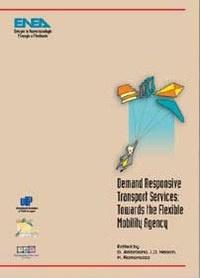Agenzia nazionale per le nuove tecnologie, l'energia e lo sviluppo economico sostenibile
PUBBLICAZIONI - Sito tematico ENEA
Demand responsive transport services: towards the flexible mobility agency

Kind of publication : VOLUME
Edited by: G. Ambrosino, J.D. Nelson, M. Romanazzo
Publisher: ENEA
pp. 328, 2004
ISBN: 88-8286-043-4
Price: free
ABSTRACT
The work assembled in this volume is concerned primarily with the potential contribution of advanced public transport systems to sustainable mobility. The focus is on the concept of Demand Responsive Transport (DRT) - an intermediate form of transport, somewhere between bus and taxi which covers a wide range of transport services ranging from less formal community transport through to area-wide service networks - and what is entailed in its successful implementation in the context of an overall programme of mobility management. The findings presented here have been assembled from the outcome of a variety of important R&D projects. The overall objective is to provide an introduction to the concept of telematics-based DRT services and analyse the results of the evaluation of a set of DRT technologies and operations at urban and rural sites across Europe while providing an informed insight into the next generation of DRT services.
The starting point is that User Needs Analysis is a fundamental building block in any project concerned with the provision of transport services. Next, a set of service typologies and scenarios for DRT are developed. The organisation of DRT services on a reasonably large scale is only possible if accompanied by a telematics-based system. An overview of DRT system architecture is offered accompanied a summary of the main technologies and standards involved in the development of DRT systems. The important role of in-vehicle technologies in the efficient operation of DRT services is explained and recent developments in flexible public transport which have increased the need for accessible vehicles of different sizes are discussed.
A major contribution of the book is a detailed analysis of the experience gained through different applications of DRT services across Europe. Results from Belgium, Finland, Italy and the UK are considered in detail. Institutional, organisational and regulatory aspects of DRT are the subject of a separate chapter and experience of two other important manifestations of DRT, namely collective taxis and car sharing is also documented. Drawing on important research findings, it is argued that starting from the single DRT services application, there is a considerable opportunity to evolve towards the concept of the Agency for Flexible Mobility Services through a scaling up of the current technologies and DRT models. This is the thesis advanced and illustrated by the EC-funded FAMS project with examples from trials in Angus, Scotland and Florence in Italy.
This volume concludes with the observation that whilst to-day, at a European level, flexible collective transport solutions cover just a small proportion of trips they can provide an alternative to the private car between 10% and 30% of trips (depending on local characteristics). The contributions to this volume have considered the range of flexible transport services, focusing particularly on Demand Responsive Transport (DRT) and have identified the "building blocks" of successful schemes.
Disponibile in formato elettronico:
Dimensione: 16.74 MB
